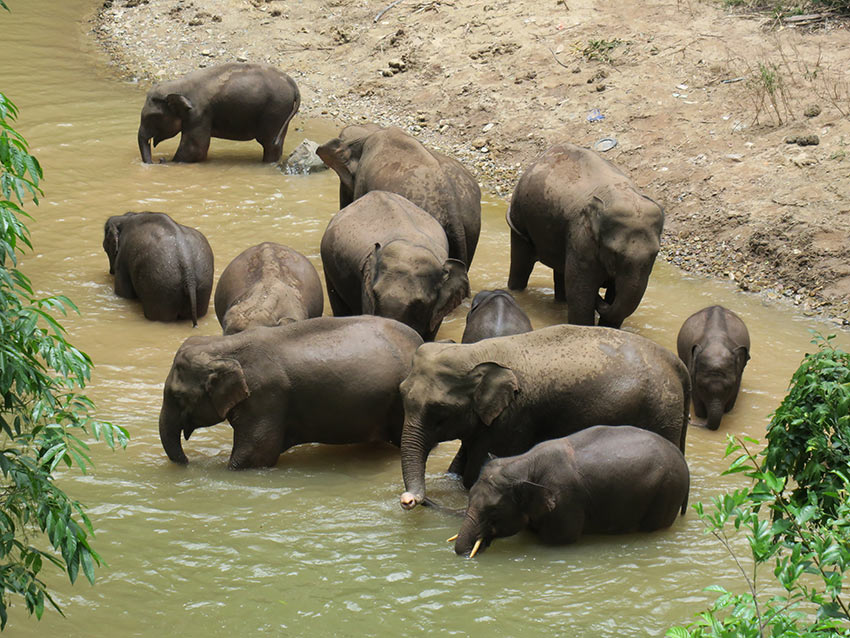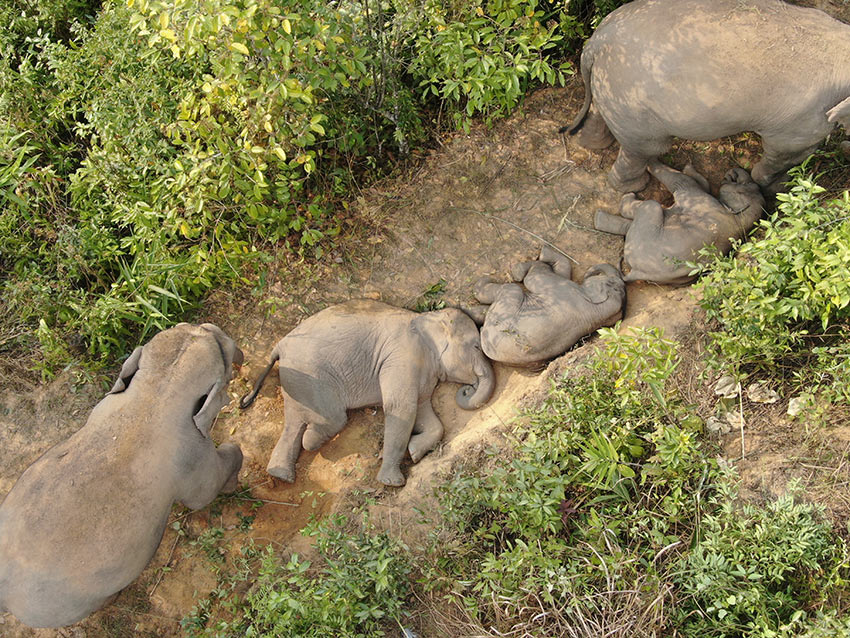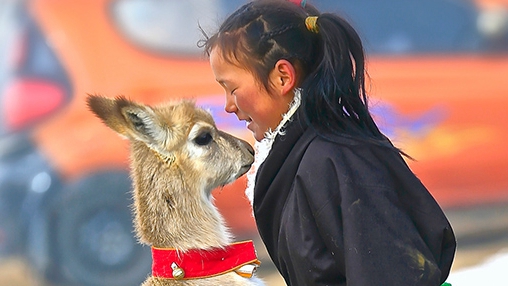SW China's Yunnan takes various measures to protect wild Asian elephants
In 2021, the northward migration of a herd of wild Asian elephants in southwest China’s Yunnan Province garnered worldwide attention. The efforts the local government and the local people had made to take care of and protect the animals along their migration route demonstrated China’s resolve to protect the animals and the achievements the country has made in this area.

Photo taken in June 2022 shows a family of wild Asian elephants seen at the Wild Elephant Valley inside the Xishuangbanna national nature reserve, southwest China’s Yunnan Province. (Photo courtesy of the management and protection bureau of the Xishuangbanna national nature reserve)
Over the past nearly 40 years, the number of wild Asian elephants in southwest China’s Yunnan Province, which is the only habitat for the species in China, increased from about 150 to about 360. Meanwhile, the relationship between the Asian wild elephants and human beings has changed profoundly.
Zhao Jinqing, a 58-year-old forest ranger, once participated in the task of rescuing two injured wild elephants. In 1998, an injured female elephant ventured outside the protection area in Xishuangbanna Dai Autonomous Prefecture, Yunnan, and was later spotted in a rice field in Nanping village, Mengla county, Xishuangbanna.
At that time, there were no elephant specialists or veterinarians residing in the locality. Zhao administered anti-inflammatory drugs for the elephant himself and fed it corn. Gradually, the elephant was able to recognize Zhao’s voice.
However, the elephant unfortunately died two months later given the severity of its injuries. In the animal’s last moments, Zhao found that the elephant was in tears and he believed that it was trying to say goodbye to him in its own way. To memorialize this touching story between Zhao and the elephant, scientific researchers produced a specimen of the elephant.
The specimen was meant to make people think about how they might do more to provide science-based and effective assistance to better protect wild Asian elephants.
In 2002, the Asian Elephant Breeding and Rescue Center was established in Xishuangbanna. In 2007, Zhao rescued another injured elephant, but this one was provided with professional medical treatment until it fully recovered. The elephant, which was given the nickname of “Ping Ping,” is currently under protection at the Asian Elephant Breeding and Rescue Center.
Over the past few years, staff members at the Asian Elephant Breeding and Rescue Center in Xishuangbanna have carried out over 20 rescue operations, during which they released some elephants that were not severely injured back into the wild, as well as providing shelter for some elephants that were deemed unfit to be released given a greater risk for exposure to safety risks upon being release into the wild.
Situated in the peripheral area of the Mengyangzi Protection Zone in Xishuangbanna, Xiangyanjing village has been frequently visited by wild Asian elephants, especially in view of the fact that the number of wild Asian elephants has continued to expand in recent years. This has in turn impacted the life of local villagers.

Photo shows a section of a fence installed in the backyard of Feng Yingping, a local villager living in Xiangyanjing village, Xishuangbanna Dai Autonomous Prefecture, southwest China’s Yunnan Province. (People’s Daily Online/Zeng Zhihui)
In 2014, residents from Xiangyanjing village were relocated to a new village site. In 2017, a fence was also built around the village to safeguard the villagers. “When the fence was just completed, some elephants had tried to enter the village through the fence, and after they failed several times, they left in the end,” said Feng Yingping, a local villager from Xiangyanjing village.
Apart from the fence, infrared cameras were also installed at crossroads and in areas where elephants would frequently visit. The cameras can intelligently identify elephants, and transmit relevant data to a monitoring and pre-warning platform, with information about nearby elephants being able to reach local villagers in only about 10 seconds through various channels, such as mobile apps, WeChat, text messages, and the village’s radio station, helping avoid any possible clashes between local residents and the elephants.
“Thanks to these protective measures, nowadays we dare to even look at the elephants directly in the eye with the fence in the middle as a protective barrier,” said Feng.
Under the guidance of the local government, some local villagers have found jobs in the Wild Elephant Valley, and some are now running agritainment businesses. The per capita net income of villagers living in Xiangyanjing village is much higher than that of their peers in other villages located in Dadugang township, Jinghong city. Xiangyanjing village has therefore been dubbed “China’s first village where human beings and wild elephants live in harmony with each other.”

Photo shows a monitoring tower, which has been set up to observe the activities of wild elephants. (People’s Daily Online/Zeng Zhihui)
An adult elephant consumes about 150 kilograms of food each day, and a herd of elephants can eat up all the crops that a farmer grows. To reduce losses caused to local villagers by the elephants, the local government of Jinghong city, Xishuangbanna, created a wild animal accident public liability insurance plan to help make up for any losses caused by the elephants.
Jose Ahimsa Campos Arceiz, a Spanish professor at the Xishuangbanna Tropical Botanical Garden of the Chinese Academy of Sciences, spoke highly of China’s efforts in handling the elephants.
“China has done a very meaningful job in protecting wild elephants. The root cause of elephant-human conflicts is that human beings and elephants share similarities in ecology, which means there is competition between the two for land, food and water. Promoting coexistence between human beings and elephants is an important step China has to take in order to properly protect wild Asian elephants, and efforts are required to reduce the impacts of ecological competition on both human beings and elephants. This is a challenge for China’s efforts in wildlife protection. However, the country has continued walking in the right direction,” he said.

A herd of elephants is seen in Jiangcheng county, Pu’er city, southwest China’s Yunnan Province. (Photo courtesy of the media convergence center of Jiangcheng county)
Photos
Related Stories
- World Elephant Day marked in S China's Guangzhou
- Action taken to reduce conflict with elephants
- Baby Asian elephant makes muddy appearance
- Wild Asian elephants rescued in Xishuangbanna, SW China
- In pics: Wingabaw Elephant Camp in Myanmar
- Kunming Zoo welcomes a newborn Asian elephant calf
- Feature: Baby elephants find sanctuary at Zambian orphanage
- Elephants return from epic journey
- Food base for Asian elephants to open soon in Yunnan
- Trapped baby elephant rescued in SW China
Copyright © 2022 People's Daily Online. All Rights Reserved.









